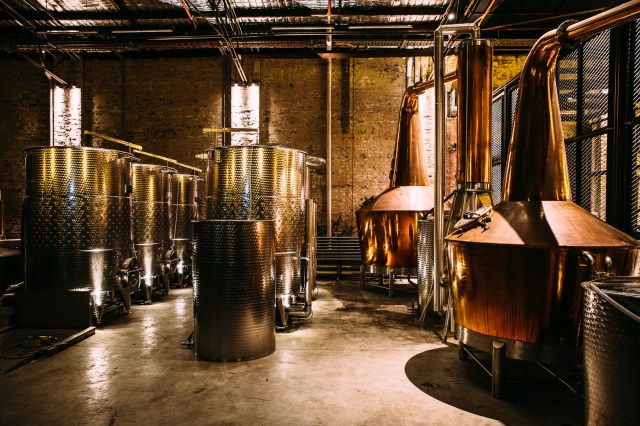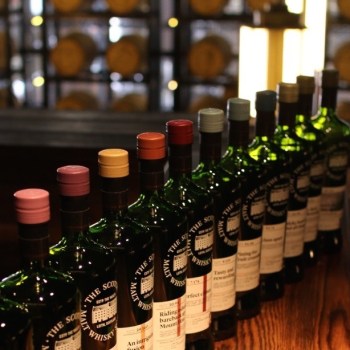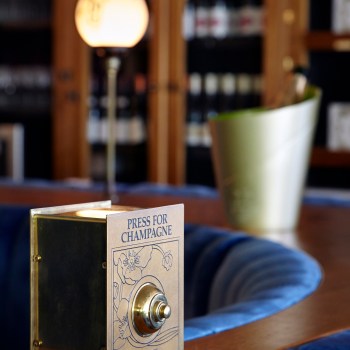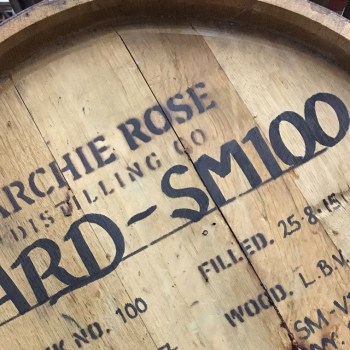It’s the first distillery in Sydney in 150 years, and needless to say, Archie Rose’s owner Will Edwards has caused something of a stir.
Will Edwards had been tossing around the idea of starting his own distillery for a decade before he decided to get serious. After following what he calls a “fairly standard corporate path” into management consulting, a trip to New York led Edwards to investigate the urban distilling scene that was, at the time, starting to pop up in the city.
“I went and visited [the distillers]. I heard their story, and how they’d set up, and you know, they had a similar background to me,” he said. “And I also saw the similarities between New York and Sydney.”
The seed was planted.
“I just thought, I’ve got to know why it can’t be done,” he says. “Because in my mind, there must have been other people who’ve tried.”
Determined to find the “deal-breaker”, and force himself to abandon the idea, Edwards set about six months’ worth of research – speaking to suppliers and even travelling to Tasmania. But the deal-breaker proved elusive.
That was two years ago now. Since then Edwards quit his job, bought a custom-built distillery and recruited a team that includes Joe Dinsmoor – the 22-year-old distilling wunderkind who cut his teeth on his very first whisky run at Lark Distilling on his 18th birthday; and Dave Withers – the whisky guru from Sydney whisky emporium Oak Barrel. He also took his girlfriend to Tasmania for a romantic trip for her birthday. Then accidentally took her to visit all of the world-famous distilleries that just happen to be there.
Edwards is a details man. You can see the glint in his eyes when he talks about his stills and the process he went through to have them made exactly how he wanted. His first stop was Forsythe’s, in Scotland, the well regarded still producer could give Edwards the degree of customization that he was looking for but in 2013, when he approached them the company was unable to deliver the finished still until the end of 2015 – out of the question for the Archie Rose timeline. Next stop was Germany, where the still producers could deliver but not offer the exact detail of customisation. So Edwards turn to his own backyard and to Peter Bailly, a Tasmanian still maker.
“When [Bailly] got into still making, he took a trip to Scotland, and went around trying to find the perfect still dimensions,” Edwards says. “He used to have a friend of his stand next to the stills at a known height and a known distance. Then he would recreate the still dimensions… he can go over them and – knowing what styles of whisky they produce – think about the flavour profile you’re looking for in your whisky and how that then translates back into the shape of the still.”
Edwards based the all details of the still – like the diameter of the neck, the height of the neck, the way the swan neck sort of curves over, and the length and slope of the line arm – on the types of whisky he likes to drink himself.
“For me, I like whiskeys that are pretty full-flavoured, and are a little bit more viscous,” he says. “I like being able to sort of chew on it.
The hand-hammered stills were built to exact specifications in order to achieve a particular style of whisky – the necks are a little shorter, and squatter than a standard still for a slightly richer, oilier spirit.
Site-wise, being close to the CBD was always the plan, and Edwards was lucky enough to be referred to a site that wasn’t technically on the market. The owners were looking for a brewery operator, once they met Edwards that plan quickly was switched to a distillery.
“For me, what I loved was actually going and visiting distilleries, and seeing the process of how you make spirit,” sys Edwards. “In Sydney, the closest was Erina. You’re not going to get in the car and drive an hour and a half to go visit.”
There was plenty to consider in the mammoth set-up task: utilities, correct zoning, six meter clearance for equipment, security (if the alcohol gets stolen Archie Rose still pays tax on it), and, of course public accessibility. Then there is licensing, which was a whole other kettle of fish.
“The main challenge is that you submit this application for a distillery, and there’s no one alive who’s ever seen one,” he says. “There’s no guidebook to run through approving a distillery, so it’s all for the first time.”
With nine months spent on the DA approval, seven months on the initial licensing, Edwards was prepared for the worst when it came to the ATO federal excise license, to manufacture. Instead all his organisation paid off – the stack of paperwork he submitted weighed close to a kilo.
“I’ve heard horror stories about people being there for years,” he says. “For us, our license took 35 days. But to do that, it took about a year of calling, working with, speaking to the ATO.”
With all the pieces in place, all that was left to do was distil the spirits. Well, almost.
“Joe actually moved up to Sydney, packed up his whole life, on the 8th of September, and the distillery didn’t even exist,” says Edwards. “[We] grabbed a coffee, and walked through. The roof’s half torn off, there’s no slab, there’s no gear here. And he was [saying], ‘Oh, this is going to be really good, you know, we’ve got a bit of work to do’. I just imagine him thinking, ‘What have I done? Who is this guy?’”
However, Dinsmoor had arrived prepared, having been working on the gin recipe for his new distillery for about a year – before there was even a solid job offer on the table. Edwards had himself created a list of 60 potential botanicals. That was quickly culled by Dinsmoor and between the two of them they began to seriously investigate between 25-30 botanicals.
“Joe was reading essential oil books from the early 1900s, trying to figure out how certain botanicals and the oils within them would translate into a botanical distillate on their way through the still,” he says. “We had [15] botanical distillates, and a huge pad of paper. Joe would then add each distillate into a beaker of wheat spirit, and we would then taste, write some notes, have a discussion, and then make the next change. And the next change. And the next change, because you can only change one variable at a time, I mean, you’re literally putting .05 of a mL of lemon myrtle distillate in, and then seeing what it’s like, and in those sessions, which went over about five days, full day sessions.”
The process used to create the gins, is unique in that Dinsmoor is distilling each botanical separately then blending each distillate into the final product. This allows the important volatiles to be controlled, and expressed in the final spirit to their best advantage. According to Dinsmoor his favourite additions are the weirder ones – like the river mint.
“I was looking sort of through these really, really basic websites,” he says. “They were some pretty classic 90s looking things, like Windows 98 specials. I was reading about river mint, and I was like, okay, yeah, cool. This is something kind of different, it’s native, it’s not really been done before, and so I thought, we’ll give that a crack. If it turns out wrong, then we’ve just got some really good Listerine for a while.”
The distillery is also producing a vodka, and although Edwards wasn’t keen on the spirit to begin with, he’s very pleased with the final product.
“There was that challenge of, we’re going to make a vodka and we’re going to make a vodka that we like,” he says. “And so we were really surprised, there was little notes of the sort of apple and the mint, and the sort of citrusy taste. Instead of just having a sip and going, ‘Oh, it’s vodka,’ we sort of had a sip and went, ‘Hang on a second,’ and had another sip and went, ‘That’s actually pretty good.’”
For Edwards and the rest of his team, the traditions of distilling are important, but so is creating an original and unique product.
“We don’t want to be hemmed in by them,” says Edwards. “We’ve created quite a traditional dry gin. An old school balanced gin. But [we] sub out the traditional ingredients, and replace them with Australian natives. So that’s why the citrus is gone, and lemon myrtle and blood limes are in. And herbal notes are sort of stripped down. So it still ends up with quite an old school dry gin flavour profile, but with a few things where you just go, that’s not quite what I was expecting.”
Continuing the healthy disregard for convention, they settled on malted rye as the base for the White Rye that is the third offering in the current portfolio. Unfortunately, this set quite the challenge for their supplier – Bintani, which has been doggedly chasing a reliable source ever since.
Likewise in the whisky production, Dinsmoor has been experimenting with wild yeasts and German smoked malts. While the latter won’t feature in his core single malts, Dinsmoor is keen to continue experimenting with malts from local suppliers who smoke grains on a very small scale.
“The first four brews of single malt [used Beechwood smoked malt],” says Dinsmoor. “It was either that or cherry wood, but the cherry wood was not a super consistent supply.”
Dinsmoor says he only used 10-15 percent of the mash bill, but the smoky flavours coming off the brew were intense and a little overpowering, thankfully the end result had mellowed.
“When it came through [the still], I was like, ‘oh, it’s so good’,” he says. “We’ll probably end up getting some more in, but I’d like to try the cherry wood, even just for shits and giggles.”
Conversely, the signature single malt uses a brewer’s barley, with distiller’s barley to “refine” the fuller flavour of the former, and a combination of three different yeasts. As for the wild yeast, Dinsmoor has been popping to tops off the fermentation vats – each one is named after a rapper like Kendrick Lamar or 2 Chainz – to introduce some local organisms.
“Not only are we sort of introducing wild yeast – because there’s not a heap in the area, [but] what we’re doing that for is to introduce lactobacillus bacteria,” he saus. “It’s going to provide us later on in the run with a rich mouthfeel, it will also hold some really nice floral notes, that’s [a technique] I picked up at Lark.”
As for when the whisky will be out of the barrels, Dinsmoor is not making any promises.
“I’m aiming for 4:38pm, January 15th, 2019,” he says. “I’d say, my best estimation would be, for the single malt, probably four years. For the aged rye, maybe three.”
And while Edwards says that he has a “crazy long list” of spirits he wants to make, Dinsmoor is a little cagier about his plans – beyond making Archie Rose the forefront of local spirits innovation.
“Some of the things that we’re going to be offering in the future, I think will be unique to us. I don’t know if I can tell you,” he says. “It’s super special. We’re working with NASA on it. I call up Barack sometimes, like, ‘Yo, Barry, do me a favour,’ and he’s like, ‘No worries, dude.’”
Certainly, the next step is conquering Australia, followed by the US – the market-specific 750mL bottles are all ready to go – then the UK and Europe.
“Spain loves their gins,” says Edwards. “The plan is to take it global. Aside from just the geographic expansion, what we’re really trying to do is, first and foremost, make amazing spirits. That’s what we do, that’s what we’re about.”



